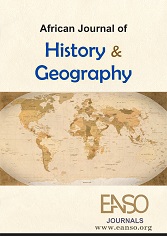The Effect of the Porous Kenya-Somalia Border on Education in Garissa County
Abstract
Globally, border regions face unique developmental challenges, particularly in fragile and conflict-affected environments. These regions are vulnerable to security threats, governance challenges, and the provision of basic services, including education. In most areas of the world, open borders are associated with cross-border criminality, migration of armed groups, smuggling, and population displacement, all bear adverse implications on public service delivery and community stability. In East Africa, the Kenya-Somalia border has long been described as porous and insecure, marked by frequent insurgent activity, refugee flows, and informal economic exchange. The porous Kenya–Somalia border has played a central role in enabling cross-border insecurity, which continues to undermine education in Garissa County. Extremist groups such as Al-Shabaab exploit the unmonitored and poorly secured border to infiltrate the region, conduct attacks, and create widespread fear among educators, students, and parents. A tragic example is the 2015 Garissa University attack, which triggered a mass exodus of non-local teachers and severely disrupted learning across the county. This study employed a qualitative research design to assess the impact of the porous Kenya–Somalia border on education in Garissa County. The study targeted key stakeholders relevant to the effect of the porous Kenya–Somalia border on education in Garissa County. Data was collected from three Deputy County Commissioners (DCCs) and twelve chiefs, purposively selected from the border sub-counties of Dadaab, Fafi, and Hulugho due to their direct involvement in security and administrative matters. Semi-structured interviews were conducted with DCCs and chiefs to gain qualitative insights into security challenges affecting education. The collected data underwent thematic qualitative analysis. Secondary literature was used to complement the primary data. The triangulation of interviews, focused group discussions (FGDs), and secondary sources enhanced the credibility and depth of the findings. Garissa County, especially the Dadaab area, has experienced continuous refugee inflows due to the unstable conditions in Somalia. These movements have placed a heavy burden on the local education system. Teachers and local leaders cited severe overcrowding in classrooms, sometimes exceeding 80 pupils per teacher, and noted shortages in textbooks and learning materials. One education officer remarked that schools lack the infrastructure and human resources to accommodate both refugee and host community children effectively. The porous Kenya-Somalia border has played a central role in undermining education in Garissa County. Cross-border insecurity has led to school attacks, teacher withdrawal, and student dropouts. These challenges, compounded by policy gaps and under-resourced emergency response systems, have fostered environments where children, especially girls, struggle to access and complete basic education. The Kenyan government, in collaboration with local leaders and regional security agencies, should enhance security along the Kenya-Somalia border. This includes deploying more well-trained and community-sensitive security personnel in border schools and education offices.
Downloads
References
Abbink, J. (2020). Violence and schooling in Ethiopia's conflict regions. African Affairs.
Abuya, B. A., Oketch, M., & Musyoka, P. (2020). Improving learning outcomes and reducing inequality in Kenya: Evidence from a literacy program. Brookings Institution. https://www.brookings.edu
Akar, B. (2018). Impact of protracted insecurity on education in Somalia. International Journal of Educational Development, 61, 1–9.
Akinola, O. (2022). Border insecurity and education in Northern Nigeria: Challenges and policy options. African Security Review, 31(2), 123–139.
Botha, A. (2020). Terrorism in Kenya and Uganda: Radicalization from a regional perspective. Institute for Security Studies. https://issafrica.org
Gándara, P., & Ee, J. (2021). Border insecurity and educational inequality in U.S. border schools. Educational Policy Analysis Archives, 29(54), 1–21.
Human Rights Watch. (2021). Kenya: Teachers flee North Eastern region over insecurity. https://www.hrw.org
Karanja, J., & Mwaura, P. (2022). Insecurity and teacher shortage in northeastern Kenya: A case study of Garissa County. Journal of African Studies and Development, 14(3), 56–65.
Kenya National Bureau of Statistics. (2019). Kenya Population and Housing Census 2019: Volume I – Population by County and Sub-County.
Khalil, J. & Onyango, P. (2022). Youth radicalisation in Kenya’s border counties: Causes, consequences, and policy options. African Centre for the Study of Violence.
Makinda, S. M., & Okumu, F. W. (2021). The African Union: Addressing border security and development. Routledge.
Ministry of Education. (2020). Education Sector Report 2019/2020–2021/2022. Government of Kenya.
Ministry of Education. (2021). Education Sector Disaster Management Policy. Government of Kenya.
National Counter Terrorism Centre (NCTC). (2021). Countering violent extremism in Kenya: Progress and challenges. Government of Kenya.
National Drought Management Authority (NDMA). (2020). Drought early warning bulletin: Garissa County. https://www.ndma.go.ke
Ong’ayo, A. (2020). Teacher deployment and the right to education in marginalized regions of Kenya. Kenya National Commission on Human Rights.
Orodho, J. A. (2014). Policies on free primary and secondary education in East Africa: Are Kenya and Tanzania on course to attain EFA goals by 2015? International Organization of Scientific Research.
Republic of Kenya. (2020). Garissa County Integrated Development Plan 2018–2022. County Government of Garissa.
Sampson, R. J., & Groves, W. B. (1989). Community structure and crime: Testing social-disorganization theory. American Journal of Sociology, 94(4), 774–802.
Shaw, C. R., & McKay, H. D. (1942). Juvenile delinquency and urban areas. University of Chicago Press.
UNESCO. (2022). Education under attack 2022. United Nations Educational, Scientific and Cultural Organization. https://www.unesco.org
UNHCR. (2021). Education in Dadaab Refugee Complex: Report and statistics. United Nations High Commissioner for Refugees. https://www.unhcr.org
UNICEF. (2021). Children displaced by conflict in Kenya: Risks and responses. United Nations Children's Fund. https://www.unicef.org
Wambua, S. M., & Njuguna, A. W. (2021). Impact of forced displacement on learners in North Eastern Kenya. International Journal of Education and Development, 8(1), 14–28.
Copyright (c) 2025 Mohamed Ali Heibe, Patrick K. Kiragu, PhD, Ruth N. Njoroge, PhD

This work is licensed under a Creative Commons Attribution 4.0 International License.




























